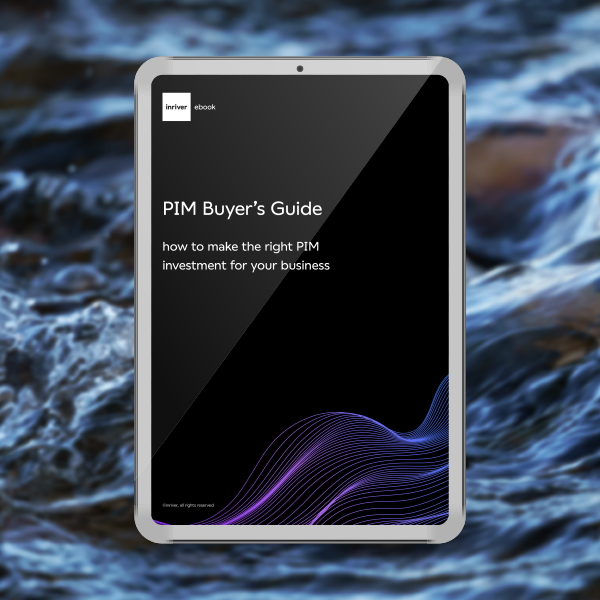What is product content management?
drill down on effective product content
See how effective product content management can transform your sales and marketing strategies thanks to the transformative power of PIM.
Without the ability to physically interact with products online, content like photos, videos, and descriptions is the lifeblood of customer experiences on the digital shelf. Product content management is the art and science of crafting and handling this influential content, ensuring each piece contributes to a coherent and compelling product story.
Understanding the power of product content management, and the role of crucial software such as a Product Information Management system (PIM), is key to unlocking the true potential of your products online. With well-crafted content, you transform every point of contact into an opportunity for connection and conversion.
> What content is involved in product content management?
> Why is product content management important?
> How does PIM enable effective product content management?
> Product content management best practices
What content is involved in product content management?
Product content management is the strategy and systems for creating, managing, and publishing rich product content across channels.
Key types of product content can include digital assets such as:
- Detailed descriptions: These texts, localized to the language and regional nuances, provide comprehensive details about the product. These details show buyers the benefit your product or service can add to their lives or how it can solve their problems.
- Product specifications: Specs are crucial for consumer decision-making, and include details like weight, dimensions, materials, care instructions, or power requirements. These specs help customers decide whether your particular product fits their needs.
- Technical specifications: Products made up of technical components, such as electronics or vehicle parts, are often accompanied by essential technical data such as processing, power information, charging, or security information.
- Sustainability documentation: With increased scrutiny surrounding ethical sourcing, modern products need clear, transparent content that details material sourcing, packaging, disposal or recyclability, toxicity, social impact, and more.
- Quality images: Capturing the product from various angles and enriched with text or graphics, images are the most common visual cornerstone of product representation.
- Enhanced content: Videos can be great to visually engage customers, highlight features, and educate on usage. Enhanced content such as Augmented Reality provides an immersive product experience for industries like fashion and furniture.
- Customer reviews: Product reviews are an increasingly essential asset on any digital shelf, supplying the social proof consumers want to see before trusting your product will work.
Using structured and unstructured data in product content management
In your product content management strategy, consider both structured data and unstructured data. Structured data—like SKUS, pricing, and inventory levels—helps your products show up in search engines and your performance analysis down the road. Unstructured data doesn’t fit into traditional databases and can include more ad hoc elements like rich media content, educational materials, and user-generated content (UGC).
Your product content management strategy should also account for language, regional, and cultural nuances depending on where your customers view the content. Using advanced PIM software, you can ensure your content makes sense in all necessary languages, includes the right cultural sentiments, and caters to the end user—wherever they are.

Why is product content management important?
The modern buyer journey is not as straightforward as it once was. It’s personalized, complex, and craves relevance at every touchpoint.
Product content management solutions empower brands to meet these expectations head-on by cultivating rich, immersive, and personalized product experiences. The goal? Ensuring every piece of content contributes to a cohesive narrative that speaks to your audience.
What’s more, a well-integrated product content management strategy provides brands, manufacturers, and retailers with a wealth of resources to make work easier across all departments—from marketing and sales to customer support.
For brands
Brands selling online must take constant stock of every touchpoint customers engage with them—from the e-commerce site to wholesale shops. Product content management for brands means maintaining a consistent, cohesive brand voice in every channel, supporting product searchability, and aligning with the brand’s overall marketing strategy.
For manufacturers
With a plethora of channels and partners alike, manufacturers know that careful product content dissemination is key. Product data should be error-free and up-to-date so that distributors and retailers receive the most accurate information—and compliance audits go off without a hitch.
For retailers
Product content management helps retailers stay competitive in an omnichannel world and build invaluable trust with consumers. Retailers who provide the most detailed product information to customers win the day, and product content management sets you up to do just that—along with driving cost-saving efficiencies in inventory and product catalog management.

How does PIM enable effective product content management?
Product Information Management software is the core of a successful product content management strategy.
A PIM system serves as your central repository for all product data—data that will soon inform or even become your vital product content.
But PIM systems aren’t just a data dumping ground. Advanced PIM systems accelerate the process of data onboarding, enrichment, and syndication so that your product data management works for you. By streamlining the transformation of raw data into rich content, PIM software helps you create better customer, partner, and employee experiences.
The capability of a PIM system to drive product content management becomes even stronger when you integrate it into your existing tech stack, including:
- ERP: As an essential tool for organizing internal processes like inventory and supply chain, you want your ERP (Enterprise Resource Planning) and PIM to talk to each other. Integrating your ERP and PIM helps you capture that valuable information from your ERP into what will be more valuable product content for your customers.
- CRM: Customer insights from your CRM (Customer Relationship Management), such as detailed reviews, can also be integrated with your PIM to provide rich product content. Plus, some advanced PIM systems allow you to customize product content based on unique customer profiles, which you can configure with help from CRM data.
- E-commerce platforms: Integrating a PIM system with e-commerce platforms helps you capture unique customer behavior and use it to add value to future customer experiences. For example, you might notice that customers often buy two of your products together, so you might choose to advertise them together in your product content.

Product content management best practices
There are a few governing rules you’ll want to have in place to get the most out of your product content management strategy within your organization:
- Centralize content for accessibility: Though it might be tempting to gatekeep content, it’s important to allow full-organization visibility on product content so that everyone has access to the right assets. Using a PIM system as a central hub for product information is one easy way to build this centrality into the framework.
- Create and share content standards: Opening up product content access to your entire organization means you’ll want to share guidelines on how to use the content. Plus, if multiple team members need to create new content, make sure your guidelines account for brand and company standards.
- Integrate rich media to enhance content: Rich media—like photos, videos, or audio files—helps make your content compelling. Integrate it as often as you can within your product content to enhance your customers’ product experience.
- Keep up with metadata: It’s important to keep product content organized and labeled for easy access and searchability, especially when team members across different departments will access it. Account for important product families, relationships, campaigns, buyer profiles, or search terms in your tags.
- Streamline with automation: Some advanced PIM systems offer AI-powered automation to help drive efficiencies in product content management within a PIM. You can use automated workflows, for example, to speed up the content creation and approval process across teams and departments.

inriver: The solution for all your product data needs
As the importance of optimized product content across customer touchpoints grows, having the right technology in place is essential for growing brands, manufacturers, and retailers. With content quality and consistency often being the make-or-break point for purchasing decisions, you need a way to efficiently manage vast amounts of content.
The inriver PIM stands out as a comprehensive content and information management solution. With built-in asset management capabilities, content syndication, and automated workflows, inriver makes it easy to efficiently pave a compelling path to purchase.
want to see the inriver PIM in action?
Schedule a personalized, guided demo with an inriver expert today to see how the inriver PIM can get more value from your product information.
you may also like…
frequently asked questions
what is product content?
Product content is any information, media, or assets used to describe a product online. Product content includes elements like product descriptions, product specifications, product images, product videos, educational materials, user guides, after-care guides, product reviews, pricing information, and inventory stock information.
what is inriver software used for?
Inriver is an all-in-one PIM solution built to scale as brands, manufacturers, retailers, and enterprise businesses grow. The inriver PIM serves as an organization’s single source of truth for all product data and information, driving organizational efficiency and more compelling customer experiences. It features built-in Product Data Syndication (PDS), extensive tech-stack integrations, automated workflows, Digital Shelf Analytics (DSA), and more.
can product content management be used independently, or is it better to integrate with other systems like PIM?
It’s recommended to integrate an advanced PIM into your product content management strategy to ensure the product data informing your content is accurate and up-to-date. Integrating with a PIM also opens additional doors to integrate other essential business systems, such as your ERP or CRM, so that every system remains consistent.
what types of digital content are involved with product content management?
Product content management software manages rich media files like photos, videos, or audio. It can also manage all your structured and unstructured data. Structured data might include prices and SKUs, while unstructured data might be an in-depth product explainer video. Any content that helps explain the details of a product can be managed by product content management.
